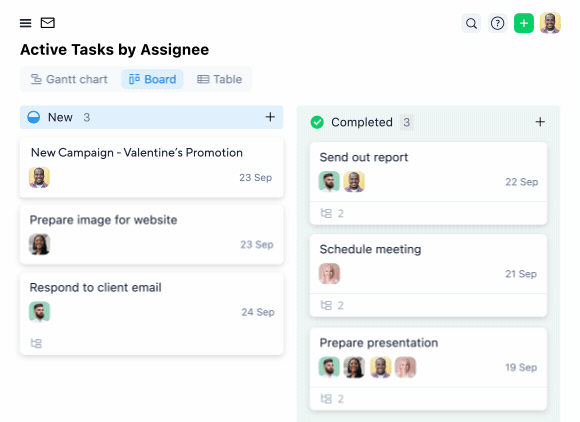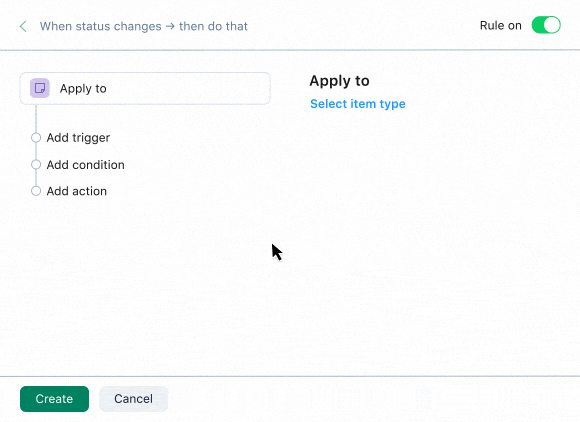An approval workflow is a system that helps you manage your team’s project approvals. It’s how you can make sure that documents and tasks get approved before being sent to clients, colleagues, or senior management. However, it’s not straightforward to operate one without dedicated approval workflow software.
Often, teams use a combination of email, paper forms, and Excel to request approvals and track their workflow. While a setup like this can work for a while, teams usually run into one or more of the following limitations:
- Approvals get lost or forgotten.
- Important projects get delayed while waiting for approval.
- Employees find the process of requesting approvals complex, bureaucratic, and tiresome.
- It’s easy to lose track of communication about approvals when it’s spread over multiple email threads with multiple people.
- Sometimes, approving a task might require the approver to manually pull in data from multiple sources, which can be frustrating and time consuming.
- There’s either no record at all of past approvals, or it takes a long time to search through an archive, especially if that archive involves filing cabinets.
Approval workflow software bypasses these issues by putting all your approvals, communication, deadlines, and task information in one central digital location, and automating a lot of the manual labor associated with approvals.
To kick off this article, I’ll explain how you should determine which solution is right for your business needs. Then, I’ll show you how Wrike can help you organize your approval workflow and I’ll also share four alternatives to Wrike.
How should you choose approval workflow software?
All standard approval workflow tools should come with certain features by default, such as automated notifications, roles and permissions, an audit trail, and automated status changes when tasks get approved.
But to find approval software that’s a cut above the rest, I advise you to also look out for:
- Interactive product tours, step-by-step tutorials, and videos that make it easy to learn the tool without requiring extensive training
- The ability to approve tasks in as few clicks as possible
- Excellent customer support through regular webinars, responsive support agents, and thriving support forums where users answer each other’s questions
- Analytics to track approval times and identify bottlenecks so that the approval process can be optimized
- Compliance with industry security standards, such as SOC 2, so you know that your data is safe
- Either tiered pricing or flexible licensing so that the platform can scale with you as you grow
- The ability to customize approval workflows by device, browser, approval stages, language, and user input
- Integrations to pull in data for your approval forms from other apps or export your completed projects to other tools in your stack
Keep these factors in mind as you read through the following list of software options.
1. Wrike
Wrike is a versatile, customizable project management platform that’s used by 20,000 organizations worldwide, including large companies such as Siemens, Aveva, and Ogilvy.
It’s ideal for managing approvals in workflows that are complex or have overlapping tasks, and makes signing off on tasks both faster and more efficient.
Some cases where you could use Wrike to approve documents include:
- Budgets
- PTO requests
- External reports
- Invoice approvals
- New vendor requests
- Contracts
- Travel expenses
- Purchase orders
- Content review for social media campaigns
Make it easy to request approvals

Some approval tools will force you to fit your tasks into prewritten workflows that don’t really reflect your business processes. Instead, Wrike lets you create custom item types, which are unique tasks that move through a workflow that you can determine.
You can also make a custom request form that collates all the necessary details for approval in one place, so it’s as easy to approve as possible. Using Wrike, it’s possible to get the approval process down to just one click on the approver’s side.
On your form, you can select what needs to be approved, e.g., an attached file. From there, you can add the approver(s) to the form, select a due date, and include any additional documents that provide approvers with the necessary context to make the right decision.
You can also request approval on a new folder or new project before it’s shared more broadly with the rest of the team by selecting “Add approval.”
Ensure approvals don’t get lost or forgotten

Wrike gives project managers 100% visibility over the approvals process from their dashboard, so they can ensure that none get missed. They can add custom widgets that filter tasks by approval status, such as:
- Approved
- In consideration
- Needs revision
- In review
To see pending approvals for a particular task, or a record of comments and feedback, all they need to do is click on the task.
Wrike also makes it easy for approvers to keep track of all the projects they need to sign off on. For example, an employee sending an approval request can use a custom task status to designate the individual approver who needs to approve that task. Wrike will then notify approvers when they need to make an approval, and any approvals in their list are prioritized by due date. This ensures that the most urgent approvals are tackled first.
Facilitate easy communication between approvers and other team members

In Wrike, all the communication between the person drafting a document and the person approving it happens in one central location, so there’s no risk of messages getting lost. It’s even possible for multiple approvers to work on the same document concurrently.
If the approver doesn’t want to approve a particular document, they can make a change request in Wrike, send it back to the employee who originally drafted it, and give it a priority level so the employee has a sense of the required urgency.
Once the approver is ready to share the document with external stakeholders, such as clients, they can also do that within Wrike by using the external requester collaboration feature to send an email. This accomplishes several things at once:
- The document gets shared.
- The external stakeholder gets asked for feedback.
- All the work associated with that document is kept within the task flow in Wrike, which acts as one central source of truth.
Much easier than going back and forth over email with multiple stakeholders!
Save time with intuitive automations
Managing approvals can sometimes feel like you need to do a lot of tedious manual labor in order to keep up with all the moving parts. Wrike’s automations eliminate a lot of this manual work. And they’re simple to use as well: just set up a when/then, as shown here:

Here are some examples of approval-related tasks that you can automate with Wrike:
- Share contextual details with approvers when creating a task, so that they have all the information needed to make the right approval decision.
- Send approvers reminders when a deadline is looming, or when a task is stuck in “Pending approval” for too long.
- Make approvals on a form conditional on having chosen a specific answer on that form.
- Send notifications to the person who’s responsible for the next stage of the approval process once you’ve changed the task status, and assign the task to that person. This could potentially mean sending the task back for revisions as well.
- Add files to a task once it’s been approved.
- Deliver files to a shared folder once they’ve been signed off on.
View details of past approvals

Whenever any sort of action is taken on a task, or any comment is made, Wrike automatically adds it to the stream of updates on that task. Naturally, some of those updates are related to approvals. Users can filter the stream of updates so they can find the approval-related ones quickly and easily.
For example, you can use this to find out:
- Who asked for an approval
- Who gave the approval
- Why approval was denied
- When approval was given
- How long the approval process took
Pass data back and forth with integrations

Approvals often require teams to pass data between tools in their stack, such as pulling data from your CRM to create an approval form or sending a project that’s been approved to a client’s Slack.
Wrike comes with over 400 integrations that allow you to pass data of this nature back and forth easily, instead of manually. One of the most popular is our integration with Adobe Creative Cloud, which allows designers to share content and collaborate within Wrike.
Other useful ones for approvals include:
- Salesforce, for pulling data from your CRM into your approval request forms
- Microsoft Teams, if you need to refer to a particular approval process during a call
- Slack, if you want to DM a coworker about an approval
- Dropbox, for reviewing historical archives of approvals
Choose the best plan for you
Whether you’re a budding startup, a scaling business, or an established enterprise, Wrike’s flexible software can cater to your unique needs. We offer a variety of pricing options (including a free plan), so you can choose the best one for your current situation. If you need to add more users as your business grows, we make that easy.
Wrike goes beyond simple approval workflows. Our paid plans offer additional features that are important for managing approvals, such as unlimited request forms, unlimited tasks, user groups and permissions, and customizable user types. We also have powerful AI capabilities, customizable dashboards, reports, Kanban boards, Gantt charts — the list goes on.
Because we offer all-in-one collaborative work management software, you might find Wrike is more streamlined and cost-effective in the long run — no more juggling multiple subscriptions for disparate tools that don’t speak to each other.
However, if you’d prefer to go with a more stripped-back option, here are four alternatives.
2. Jotform
Jotform is an online form builder that’s primarily used for B2B use cases. One of those is building approval forms.
The software is easy to use, and it’s much faster to create an approval form using Jotform’s no-code, drag-and-drop interface than it is to code them in-house. The forms themselves can be simple if that’s what you need, but conditional logic and custom triggers also mean that they can support more complex use cases if necessary.
Once an approval form has been created, managers can set up different roles and permissions, so that only team members who are designated as approvers can approve forms. Clients or team members receive notifications automatically whenever an approval form is assigned to them. And a built-in e-signature widget makes the act of approving the form extremely straightforward.
For teams that need to pull in data to their approval forms from external platforms, Jotform also offers integrations with tools like Box, Airtable, PayPal, Google Workspace, and Slack.
3. Filestage
Filestage brands itself as online proofing software, and is primarily used by agencies, marketing departments, and creative teams to manage their approval workflows.
The software collates all your approvals into one centralized dashboard, which makes it easy to see what stage of the process each approval is at, all in one place. You can click on each approval task to see who’s responsible for the approval, when it’s due, and any extra context that’s helpful for that project. You can also go back through past approvals to look at old file versions and see when they were approved.
Collaboration on approvals is straightforward inside Filestage. It’s possible for approvers to leave comments on files and discuss changes in real time. These approvers don’t necessarily have to be internal employees; you can also use Filestage to invite an unlimited number of external approvers. The system routes your content to them automatically once it’s been approved by your internal team.
Filestage offers a handful of native integrations with tools like Slack, Teams, Figma, and OneDrive. If you want to use data from other tools, it also has a Zapier connector that will allow you to integrate with thousands of other apps.
4. Approval Studio
Approval Studio is another online proofing tool, this time for approvals related to artwork, design, and similar creative projects.
This tool has a number of features that reflect its niche. For example, approvers can compare two different versions of a mockup side by side, on one screen, and use five different annotation shapes to highlight any areas they want to comment on. Both approvers and designers also get access to an on-screen ruler so they can ensure the length of various design elements is as it should be.
Approval-related communication is simple, with approvers and designers able to participate in real-time conversations on the same document. If approval is denied for a particular project, it automatically gets assigned back to the designer for edits. The software will automatically tag the project as in need of edits, so it’s easy for designers to see what they have to do to move the process forward.
Approval Studio offers fewer integrations than some of the other tools in this article, but designers will appreciate the integration with Creative Cloud. It also has a dedicated Shopify app, so this tool really shines if you need to review creative materials for a Shopify store.
5. IntelligenceBank
IntelligenceBank is a marketing operations platform that’s known for the strength of its content approval process. Marketing teams can use it to make creative briefs and then get them approved to fit with high-level brand guidelines. There are templates available for both briefing and for content creation itself.
The document approval process is quick and robust, with approvers aided by a combination of brand checklists and an AI-led compliance review. When approvers find a section in the content they want to highlight, they can draw on top of it, so it stands out to the rest of the team.
For managers looking to streamline their content approval system, there’s a comprehensive audit trail feature that lets you go back through past approvals to see where the bottlenecks were. Managers can also get approvers to track the time they spend reviewing different items, which is a nice feature to have if you’re looking to speed up the process.
IntelligenceBank offers a large amount of integrations, with some of the most useful ones for this niche being WordPress, Optimizely, Canva, Google Docs, and even Getty Images.
For a stress-free approvals process, choose Wrike
For teams that are managing their approvals over email, it’s easy to lose track of who said what and when approvals are due. But it doesn’t need to be that way.
Wrike’s powerful approval management software centralizes the whole approval workflow and the communications around it, pulls in all the data you need from the rest of your stack, and automates manual tasks like notifying managers when they need to approve something. This makes for an approval process that’s easy, consistent, and fast.
If you’re ready to ensure that your approvals never get lost or forgotten again, start your free trial today.





